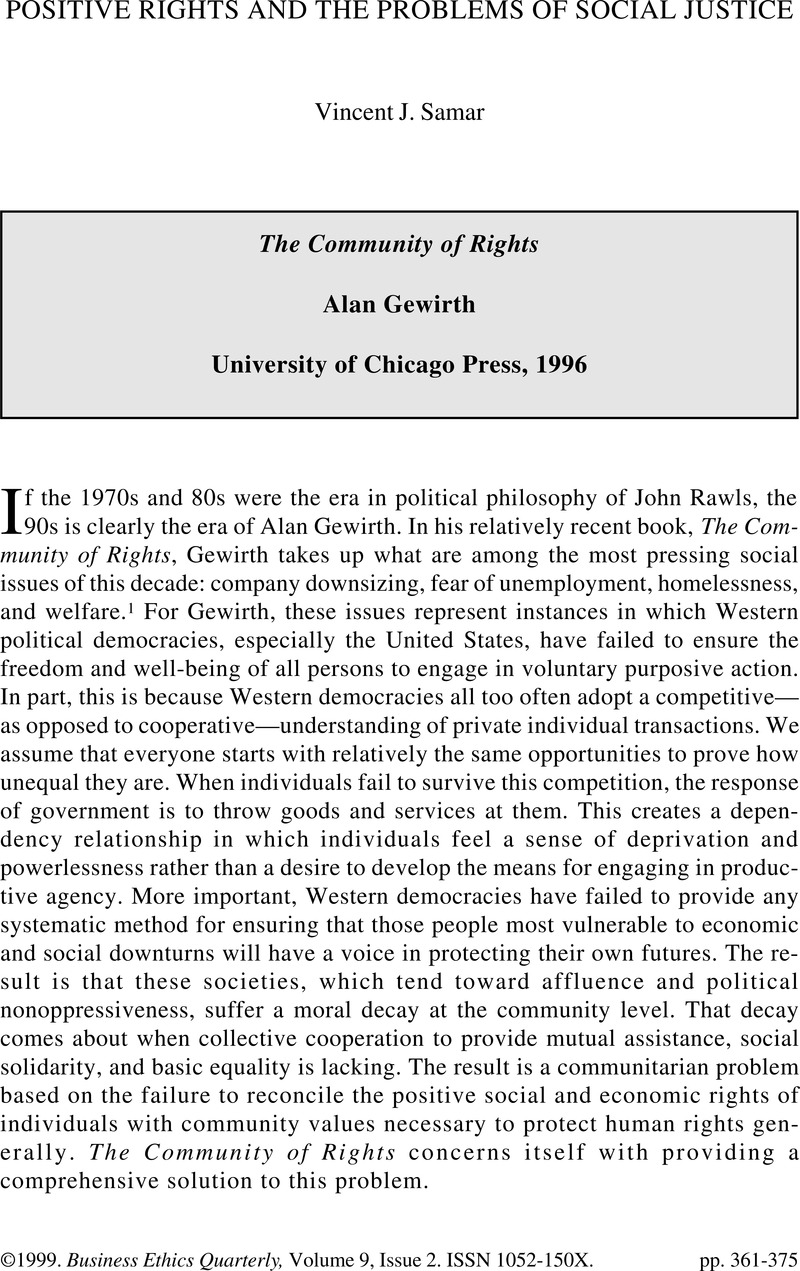Article contents
Positive Rights and the Problems of Social Justice
Published online by Cambridge University Press: 23 January 2015
Abstract

- Type
- Review Articles
- Information
- Copyright
- Copyright © Society for Business Ethics 1999
References
Notes
1 The seriousness with which these issues are held by the American public got an initial airing in the 1996 United States presidential primary campaign when the State of New Hampshire shocked most of the nation by electing as its Republican presidential hopeful right-winger Patrick Buchanan. Apparently, Buchanan was able to strike a note of accord with a middle-class segment of the American public on the fears they had regarding their future economic well-being. This allowed him to shift the debate away from his own extremist views, thus catching off guard more mainstream candidates who had failed to take up these issues.
2 See Alan Gewirth, The Community of Rights (Chicago: University of Chicago Press, 1996), p. 17, reflecting work done by him previously in his book Reason and Morality (Chicago: University of Chicago Press, 1978). Subsequent paraphrases are to this cite.
3 A good example of this problem is Illinois AIDS Drug Reimbursement program. Under the program, if a single head of household earns more than $15,480 (200 percent of the federal poverty level which for a single family household is $7,740) and applies after June 4, 1996, he or she no longer qualifies for AIDS medications reimbursement. See 77 Ill. Adm. Code 692Appendix A (June 4, 1996). Previously, the financial cutoff had been 400 percent, or twice the current figure. AIDS combination antiviral treatment medications—which now include AZT with 3TC or DDI and at least one protease inhibitor—cost approximately $1300 per month. This means that if a person earns one dollar over the qualifying amount, they will have less than a thousand dollars to live on for the year. More to the point is that the system has created a disincentive for persons who want to work from carrying on productive lives, which adds to a personal sense of dependence on an already overburdened welfare system. This supports neither the development or continuation of productive agency nor the sense of a community of rights that Gewirth has in mind.
4 Alan Gewirth, The Community of Rights, p. 116, note 2.
5 In response to the state of Hawaii’s pending legalization of same-sex marriage, the federal government and 16 states adopted laws declaring it a violation of their public policy to recognize same-sex marriages. The point of these laws is to set forth a public policy to deny both legal recognition and accompanying benefits to same-sex couples under the full faith and credit clause of the federal constitution. Whether this strategy ultimately succeeds will be a question for federal constitutional jurisprudence. See, e.g., Defense of Marriage Act (DOMA), Pub. L. 104-199, —Stat.— (1996).
6 In Baher v. Mike, No. CIV. 911394, 1996 WL 694235 (Hawaii Cir.Ct., 1996), a Hawaii circuit court found unconstitutional, under the equal protection clause of the state’s constitution, the state’s refusal to grant same-sex marriage licenses.
7 See Vincent J. Samar, “A Moral Justification of Gay and Lesbian Civil Rights Legislation,” in Gay Ethics: Controversies in Outing, Civil Rights, and Sexual Science, ed. Timothy F. Murphy (New York: Haworth, 1994), p. 147.
8 Alan Gewirth, The Community of Rights, p. 147, note 2.
9 Ibid., p. 199.
10 Note that Cass Sunstein argues that laws affecting property rights are not neutral since such rights are, in their current form, themselves a product of law and not nature. See Cass Sunstein, The Partial Constitution (Cambridge, Mass.: Harvard University Press, 1993), pp. 68–69.
11 See John Locke, Second Treatise of Government, ed. C. B. Macpherson (Indianapolis: Hackett, 1980), sec. 27; see also Judith Jarvis Thompson, The Realm of Rights (Cambridge, Mass. Harvard University Press, 1990), p. 334 (discussing the “Jointly-Owned-from- the-Outset” thesis).
12 Alan Gewirth, The Community of Rights, p. 215, note 2.
13 For an interesting critique of the role inheritance plays in stifling capitalism, see D. W. Haslett, “Is Inheritance Justified?” Philosophy and Public Affairs 15 (Spring 1986).
14 See, e.g., Patricia H. Werhane, “Employee and Employer Rights in an Institutional Context,” in Moral Issues in Business, ed. William H. Shaw and Vincent Barry, 6th ed. (Belmont: Wadsworth, 1995), p. 293. In Illinois, for example, the state Supreme Court has held that any employment manual or employee pamphlet will offset employment at will by making whatever provisions it contains quasi-contractual.
15 United Airlines has a stock ownership program with some of its employees.
16 Alan Gewirth, The Community of Rights, p. 268, note 2.
17 In the Mondragon system, individual firms practice economic democracy internally. There is also a supportive organization that is made up of an assembly of elected members from the particular firms. A main component of the assembly is operation of a cooperative bank —financed by the member firms—to encourage entrepreneurship among the members. The bank functions to provide market information and resources to assist struggling firms from going bankrupt. The organization also promotes education from elementary schools to postgraduate education within the community to enhance productive agency.
18 For a discussion of this point, see Cass Sunstein, Democracy and the Problem of Free Speech (New York: Free Press, 1993), pp. 103–105.
- 3
- Cited by




